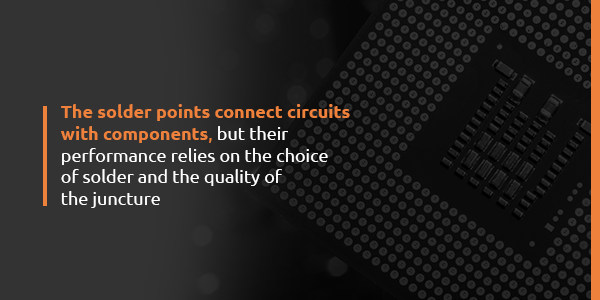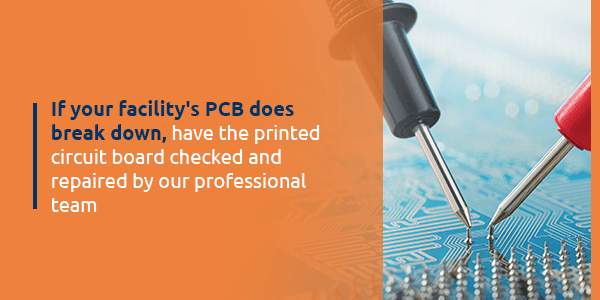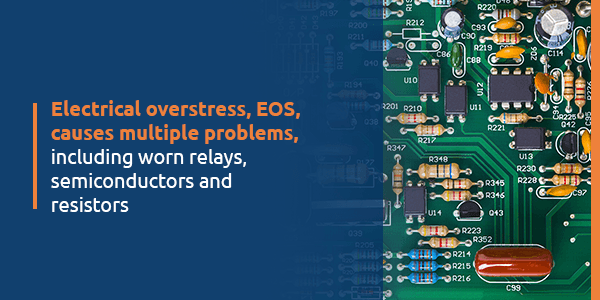Common Causes of Failure for Electronic Components
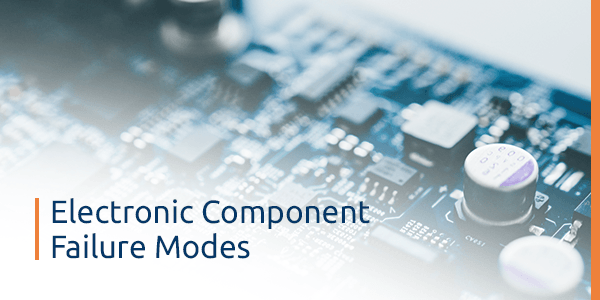
Nothing lasts forever, not even electronic components. While many reasons exist for failure, several modes serve as the primary suspects. We’ll review common causes of electronic equipment failure in this post. After checking these points, look for other causes for your company’s electronic equipment not working. Learn to recognize the most effective methods of preventing the most common failure modes and what your company should do when electronics fail.
Read on to learn more about common causes of the failure of electronic components.
Quick Links
Main Types of Failure Modes
Packaging
Solder Contacts
Printed Circuit Boards (PCB)
Other Types of Failures
Find Reliable Sensor Repair Services
Main Types of Failure Modes for Electronics
While equipment, even electronics, has a higher likelihood of failure at the end of its life, electronics also have a significant failure rate at the beginning of service. If your company’s electronics did not undergo a burn-in procedure to test for and replace weak components, you might need repairs shortly after having your facility’s equipment put into service. When we repair components, we put them through extensive testing before returning the parts to your facility to ensure their longevity.
Even well-tested devices can still suffer a breakdown. The most frequently seen electronic failure modes are the packaging, contacts, and printed circuit boards—PCB. These points undergo significant stress during use, increasing their rate of encountering problems and causing damage.
To reduce downtime in your facility from electronic failures, you must understand the causes of these parts breaking down and how to prevent them. Prevention and rapid repairs will both help you improve uptime and productivity at your facility.
1. Packaging
Packaging plays a critical role in protecting electronic components and holding connections with other parts. Because it is the exterior of an electronic device, the packaging encounters more environmental hazards—heat, cold, dust, impacts and scratches. Exposure to these factors increases on a factory floor where dust, debris and extreme temperatures can impact the integrity of the container.
Cracks in the packaging can allow moisture or dust inside, which can short the circuits. Additionally, poor installation of the packaging may damage the wiring inside the electronics. Knowing why these issues occur and understanding the protection method for each electronic is your company’s first step in developing a program to prevent such productivity-stealing problems.
Causes
The physical structure of the packaging may fail from poor maintenance and storage. Common causes of cracking include temperature extremes, exposure to ultraviolet light and using corrosive chemicals. Mechanical shocks, vibrations or thermal shocks may also lead to problems with the packaging early in the device’s use. Electronic devices used in coastal areas may sustain salt spray damage or corrosion from excessive levels of humidity, particularly the metal parts.
Other causes of packaging problems have their roots in the construction of the electronics. Gases, chemicals or humidity not adequately released from the interior could cause corrosion of the wiring. Just as chemicals and moisture need to stay outside the structure, they must not remain inside the casing either. Originating from inside the device, they can do the same level of harm to circuits as if they seeped in from the outside.
Additionally, if the builders did not put the exterior over the completed circuitry correctly, they may have dislodged connections or even severed wires. Loose wiring may work for a short while in your facility, and your operators may not notice a problem until after installation and use.
Prevention
While not all means of packaging failure are preventable, your facility can avoid downtime by training its employees in taking measures to prevent some causes. Always consult the information that comes with electronics for details about the environmental conditions you can use them in. If your factory floor gets too hot or humid, consider installing the electronics in a climate-controlled space.
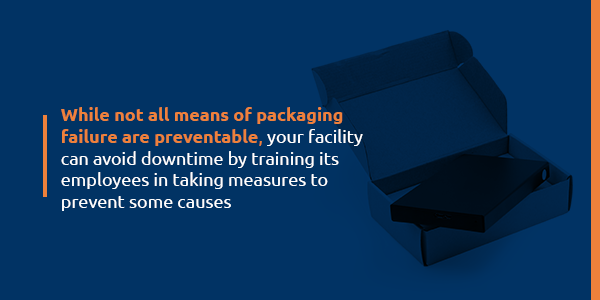
Training workers in proper care and cleaning of electronics will prevent damage to packaging from using corrosive cleaners. Not using corrosive chemicals to etch on the exterior of electronics will also prevent chemical contamination of the packaging and the components inside.
When it comes to preventing damage to seals and the internal portions of packaging, there is little to do other than request proper testing before having the electronics installed. Insisting on burn-in procedures for all electronics purchased and conducting careful visual inspections of the packaging can help prevent the installation of devices with manufacturing defects.
2. Solder Contacts
The solder points connect circuits with components, but their performance relies on the choice of solder and the quality of the juncture. Damage at the solder joints may occur over time or suddenly. Several causes could explain the failure at these contact points—poor soldering, thermal cycles, tin whiskers or contamination.
Causes
Not using the correct solder for an application or poor-quality soldering work can lead to electromigration. This process results in the formation of intermetallic layers. These layers will separate, breaking the solder joint. Unfortunately, this type of damage does not appear at first. It takes time for intermetallic layers to develop. Even if the manufacturing process used the correct solder, other problems could cause breakage of these joints.
Thermal cycles occur when the components in electronics heat and cool through typical use. These extremes of hot and cold can lead to fatigue of the solder, resulting in the material cracking. Solder that has a different thermal expansion rate from the surfaces it joins is most susceptible to damage from temperature cycling.
Tin whiskers may occur with lead-free soldering. These tiny metallic whiskers pose a problem in their formation with breakage or bridging. When tin whiskers break off, they can wear away the solder joints. The broken components may also contaminate the interior of the electronics. The opposite problem of breakage occurs when the whiskers grow too large and make connections. Tin whiskers that bridge points and make inadvertent contacts between wires or circuits may lead to electrical shorts.
Failed soldering joints could dislodge the edges of cables. Frayed cables may result in sparking or fires inside the electronics.
Prevention
Preventing failure of solder contacts is less straightforward than with packaging issues because many issues do not present readily apparent problems. An operator likely won’t notice problems unless something goes wrong, which may happen only after extensive damage to the solder joints occurs.
One means of preventing issues with soldering is verifying the production method used follows all requirements. Check the quality of the electronics from the manufacturer and only choose a maker with a record of well-made devices.
Consider consulting services to get a professional eye on your facility’s situation and electronic needs. We offer on-site assessments of your facility and the equipment you have to guide you in making better purchasing decisions to improve productivity and save money. You may find you need to purchase fewer electronics, which will prevent solder contact problems by reducing the number of devices with such joints.
3. Printed Circuit Boards (PCB)
The heart of electronic devices, printed circuit boards, have a higher chance of being the cause of the problem. These intricate devices require precise manufacturing and maintenance to continue to operate at their peak. Several issues can cause a PCB to fail, leading to a complete breakdown of the entire machine.

The complexity of circuit boards contributes to the high number of causes of their failure. However, many reasons for breakdowns have viable prevention methods to increase your facility’s uptime.
Causes
Where your facility uses an electronic device can cause problems with the PCB just as much as the manufacturing process put into the circuit board. Most failures, however, occur because of environmental causes rather than manufacturing defects.
Contamination of the circuit board can happen from dust, moisture, solder flux or whiskers reaching the PCB and stopping needed connections or creating unneeded ones. Even insects can get inside electronics and cause PCB failure.
High temperatures during soldering or from environmental exposure may cause discoloration or delamination of the PCB. Heat during thermal cycling can also cause damage to the PCB.
Manufacturing errors such as misalignment, using the wrong plating or choosing an incompatible copper weight may allow the circuit board to work for a short while. Ultimately, however, the PCB will not last as long with such poor construction. Incorrect plating or copper weight enhance the heat stress components encounter, reducing the life of the board.
If the manufacturer does not remove excessive solder flux from the PCB, the material can corrode components of the circuitry. Cleaning agents and other leaking parts can also result in corrosion of the PCB.
While many of these causes happen during manufacture or assembly of PCBs, there are still ways your facility can prevent damage.
Prevention
While you will not have control over what the PCB maker did, you can affect where you operate the machine. Avoid storing or using the electronic device in high-temperature settings. During use, the device will generate heat which, coupled with environmental heat stress, could lead to internal damage of the PCB. Preventing this type of thermal stress can protect the PCB from damage.

Too much dust buildup does more than make the PCB dirty. Combined with moisture, the dust can become conductive, creating shorts. Additionally, insects such as ants or mosquitos can get inside the electronics and also cause problems. One failure analyst discovered a cache of mosquitos that accumulated inside an electronic device used in a janitorial closet in a hot, humid environment. Regular cleaning and pest control and keeping electronics in cool, dry places can prevent such causes of PCB failure.
Over time, components of the circuit board will wear out. Exchanging older parts for new ones will avoid the cost of replacing the entire PCB while extending the life of the unit. However, not all components of a PCB will need replacement. Depending on the extent of damage, older parts may only need adjustments or repairs instead of replacements if they breakdown from a mechanical error instead of wearing out from age.
If your facility’s PCB does break down, have the printed circuit board checked and repaired by our professional team. When this part fails, we thoroughly test the PCB to identify all points of failure to fix them quickly. We may replace, repair or adjust damaged components to get the PCB functioning again.
Other Types of Failures
The three most common types of failure modes do not account for all electronics problems. Other part malfunctions such as those with relays, semiconductors, electrical overstress, ground loops, capacitors and resistors can lead to a complete breakdown.
1. Relay
Relays inside the electronics may experience problems that lead to failure. These problems include damage from electrical overstress such as melting or coil damage. Improperly sealed electronics may get moisture, dust or cleaning agents inside that can affect the operation of relays. Arching may damage the contacts, and heat stress can lead to cracking of the plastic body.
Preventing these problems mirrors the methods used to avoid the most common component failures. Ensuring the packaging has proper seals will keep the interior protected. Additionally, avoiding using the electronics in a location that experiences high temperatures can prevent thermal stress from the environment.
Unfortunately, aside from through testing before using a new electronic device, your facility can do little to avoid thermal stress caused by the heat produced during normal use or from electrical overstress.
2. Semiconductor
![]()
Semiconductors have many reasons for failure. Failure may happen for any of the following reasons:
- Thermal stress that causes cracking of the encapsulation.
- Poor storage that allows moisture or humidity to penetrate.
- Metallization damage from heat, corrosion, or electrical overstress.
- Material defects, including impurities, may cause problems in the oxide layer or semiconductor crystals.
- Leaks at the juncture between the p-type and n-type semiconductor materials.
- Design faults that create misaligned layers.
- Electromigration along the current path.
- Electrical overstress leading to bond wires snapping.
Preventing these semiconductor problems starts with testing of the system and conducting preventative maintenance. Using electronic devices in climate-controlled areas will help avoid problems with overheating or thermal stress.
3. Electrical Overstress
Electrical overstress, EOS, causes multiple problems, including worn relays, semiconductors and resistors. EOS is one of the top reasons behind component failure, along with thermal stress, nearby parts, mishandling and mechanical impacts.
EOS damage causes visible signs of an issue when viewing the part under a high-power visual microscope or an infrared model. For example, IC failure modes caused by EOS appear under both visual light and infrared—IR—microscopes. EOS results in diode failure modes and problems originating in many other parts of the system.
EOS sends excessive amounts of electricity through components, causing localized heat. The heat and electricity can damage metallization, melt plastic encapsulations and harm coils.
Because electrostatic discharge—ESD—also involves too much electricity from static energy flowing through components, it is a subtype of EOS and can cause similar damage. ESD, though, happens once and does not typically repeat, whereas EOS occurs continually until the source of the electricity stops sending a current.
Causes of EOS include poorly wired equipment, especially if the neutral and ground wires are in the wrong places. Ground loops also can lead to EOS as can a lack of grounding.
To avoid many EOS incidents, ensuring electronics have good grounding is key. Another method to prevent EOS is by using EMI filters between the electronic and the outlet. These filters reduce the noise created from power lines entering your facility.
4. Ground Loops
Ground loop failures raise the chances of electric shocks to users. This type of problem occurs when the grounds have an electrical potential instead of grounding the charge. A ground loop happens whenever two connections don’t have the same potential but share a current. This problem doesn’t only happen with grounds, but grounds are the most common site of the issue.
Poor design can create this type of loop. In some cases, the accidental creation of connections to the ground can make this type of loop. Electronic interference in audio or video from the electronics could indicate a ground loop.
Preventing ground loops starts with quality construction. Finding and fixing ground loops may require disconnecting every wire until the ground loop breaks. Another method uses an exciter to send a high-voltage test current through the system and a detector to find the circuit through which the current passes. This innovative means of finding ground loops does not repair the problem but only identifies their location.
5. Capacitors
When a capacitor is a failure mode, it may appear bulged out at the top. Causes behind this damage may include short circuits, open circuits, polarity reversals, aging, exposure to humidity, high temperatures, current leaks, insulation resistance wear and EOS. In some instances, poor construction, such as installing heat sinks next to electrolytic capacitors may lead to failure.
Using electronics in a cool, dry environment can prevent damage from excessive heat and humidity. Determining why the capacitor failed can help you take measures to prevent that reason from causing the problem again. Conducting failure analysis after a capacitor problem will find the reason the capacitor was a failure mode for the device.
6. Resistors
EOS may cause thermal stress, which leads to open circuits in resistor failure modes. Just as capacitors can reduce their ability to function as designed when exposed to hot temperatures and humidity, resistors can, too. Cracks can also cause open circuits, resulting in resistor failure.
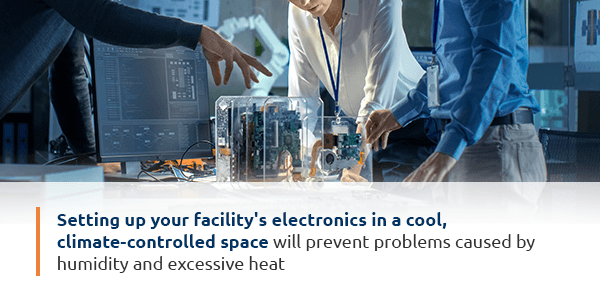
Again, setting up your facility’s electronics in a cool, climate-controlled space will prevent problems caused by humidity and excessive heat.
7. Frequent Failure Causes
While many components of electronics can fail, the root causes come down to many similar reasons. These factors affect many parts of electronics, which explains why recognizing and preventing these problems could help your facility avoid many part failures.
- Environmental: Heat, humidity and vibrations can all lead to damage to delicate electronics. Keeping devices in climate-controlled rooms can prevent harm from this cause.
- Mechanical: This type of damage to the individual parts may occur due to poor soldering jobs, mismatched thermal expansions and component defects.
- Stress: Heat stress or electrical stress may happen locally, causing severe damage to parts, which leads to electronic failure.
- Age: As electronic components age, the chances of failure increase due to natural wear. Aging failures result in the rise of problems late in the life of electronic devices.
Find Reliable Sensor Repair Services

While understanding these failure modes will help with diagnosing problems, know that your company does not need a repair person on hand to solve them. Our team can take care of all of your electronics repairs for you.
At Global Electronic Services, we have factory-trained and certified technicians to make repairs. When you partner with us, your repairs come with an 18-month in-service warranty, surpassing the industry standard by 50%.
We understand how much your facility relies on its electronics to get the job done. To help you reduce downtime when you need repairs, we offer rapid service turnaround times. Our standard service has a one-to-five-day turnaround time. If you need your repair faster, we can reduce the time to one to two days.
We keep up with both your schedule and budget. Our upfront pricing won’t leave you with any surprises. If you find a competitor that charges less, we will beat their price by 10%.
Your company relies on electronics to get work done promptly. When something goes wrong, trust us at Global Electronic Services to manage your repairs. You will get expert service, fast turnarounds and clear pricing. Contact us today for repair and maintenance services for your sensors and other industrial electronics.

